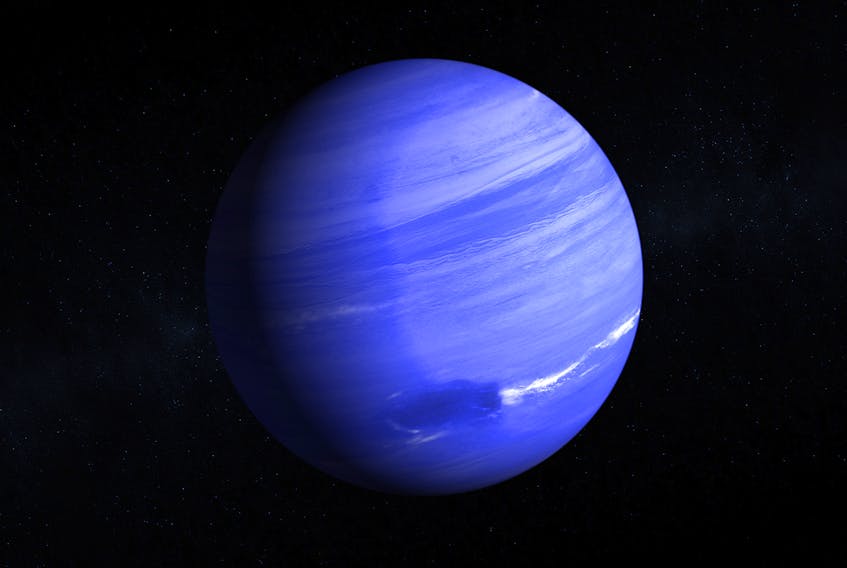Named for the Roman god of the sea (counterpart to the Greek god of the ocean Poseidon), Neptune is the eighth planet from the sun, and by some recent reckoning, the farthest planet from the sun (more about that next week, when I discuss Pluto).
It is the fourth largest, and third heaviest planet. Orbiting at a far-flung distance of 4.5 billion kilometres (30.1 AUs) from the sun, Neptune has an orbital period of 164.86 Earth years (no one alive today has seen Neptune complete one orbit around the sun); an equatorial diameter of 49, 528 kms (approx. 3.9 times that of Earth); and an orbital rotation of just over 16 hours.
Its atmosphere, like its near-twin, Uranus, is composed of primarily hydrogen (79 per cent), helium (18 per cent), and three per cent methane, water vapor and ammonia. In fact, it is the presence of methane in the atmosphere that gives Neptune its distinctive blue-green colour.
Neptune has the distinction of being the first planet discovered, not by direct observation, but by calculation. When Uranus was discovered in the mid-1800s, astronomers detected a discrepancy between its predicted location and its observed location, suggesting the presence of another undiscovered planet beyond Uranus which was causing Uranus to deviate slightly from its predicted orbit. Through the calculations of the British mathematician, John Couch Adams, and French astronomer, Jean Joseph Le Verrier, Neptune was discovered by German astronomer, Johann Gottfried Galle, on Sept. 23, 1846. It is generally believed, however, that the Italian astronomer, Galileo, probably spotted Neptune back in the 1600s (though he would not have recognized it as a planet), as some of his drawings of the night sky show a "star" very close to Neptune's location when it was discovered in 1846.
Little was known about Neptune until Voyager 2's flyby in 1989. This flyby showed clearly visible cloud patterns in the planet's atmosphere, much like those of Jupiter. Voyager 2 cameras showed faint cloud belts and zones parallel to Neptune's equator, again, like those on Jupiter. It also spotted a giant storm system in Neptune's southern hemisphere, subsequently named the Great Dark Spot, similar to Jupiter's Great Red Spot. Interestingly, this massive storm system had disappeared from Neptune's atmosphere when the Hubble Space Telescope viewed the planet in 1994, although another dark storm appeared in the planet's northern hemisphere the following year.
High altitude clouds were also seen, which puzzled astronomers. Due to its extreme distance from the sun, Neptune receives only half as much energy from the sun, as does Uranus. For Neptune to have such an active atmosphere, it is believed that it has an internal energy source, and that the planet is still slowly contracting from when it was first formed, with this contraction converting gravitational energy into internal thermal energy, which, in turn, drives the planet's atmospheric activity.
Neptune has 13 known moons/satellites, named for mythological beings associated with water bodies. While the majority of them are small, icy bodies, the largest of them, Triton (discovered shortly after the planet itself), stands out for a number of reasons. Triton has a retrograde orbit, opposite to Neptune's direction of orbit. This is thought to have occurred when Triton was captured by Neptune's gravity after the planet collided with another now-vanished satellite. It was thought, in 1846, that Triton was the only moon of Neptune, until the next largest moon, Nereid, was discovered in 1949.
Like its celestial neighbour, Uranus, Neptune also has a system of faint, dark rings, primarily carbon-covered methane ice and rock. Neptune, at magnitude +7.7, can be seen in medium-size telescopes with the help of a good star chart, particularly when it is at its brightest at opposition with the sun.
Jupiter (mag. -1.7) is still visible in the southwest sky at dusk. Venus appears below Jupiter in the southwest sky just after sunset. It has been rising higher in the sky and drawing closer to Jupiter with each passing day. The two planets are heading towards a conjunction with each other on Nov. 24, when the two planets will appear at their closest to each other in the darkening sky.
Sitting to the lower left of Jupiter, Venus (mag. -3.8) is two times as bright as Jupiter. Saturn (mag.+0.6) appears well above and to the upper left of Venus and Jupiter about an hour after sunset. Mag. +1.8 Mars is now a pre-dawn object in the east-southeast sky. The waning, crescent moon sits just north of Mars on the morning of Nov. 24. Mercury (mag. -0.3) makes its finest morning apparition of the year on that morning, sitting to the lower left of Mars above the eastern horizon an hour before sunrise.
Until next time, clear skies. Next week - the dwarf planets.
Events:
- Nov. 19 - Last quarter moon
- Nov. 23 - Moon at perigee (closest to Earth)
Glenn K. Roberts lives in Stratford, P.E.I., and has been an avid amateur astronomer since he was a small child. He welcomes comments from readers, and anyone who would like to do so is encouraged to email him at [email protected].









